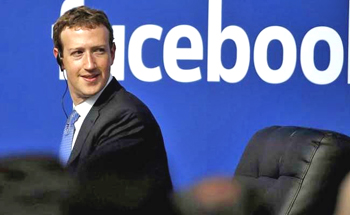San Jose, Calif, Apr 20: Three days after a man broadcast himself committing murder on Facebook, the social platform was all about playfulness again.
 At the company's annual developer's conference, held in nondescript conference center in downtown San Jose this week, Facebook launched a slew of products and features that encouraged people to use its service to snap images and video of themselves goofing off.
At the company's annual developer's conference, held in nondescript conference center in downtown San Jose this week, Facebook launched a slew of products and features that encouraged people to use its service to snap images and video of themselves goofing off.
"Photos and videos are becoming more central to how we share than text," Zuckerberg said in his keynote. "So the camera needs to be more central than the text box in all of our apps."
Aside from a single comment by chief executive Mark Zuckerberg in his keynote address Tuesday morning, in which he expressed condolences to the family of the victim and vowed to "do all we can to prevent tragedies," there was almost no mention of the murder, which was posted on Facebook on Easter Sunday. The killer later used Facebook Live to boast about the shooting.
Critics have said that because Facebook has not established a rigorous system of vetting videos and live-streams, the company is creating an environment in which its policies prohibiting the display of graphic content will inevitably be broken and more murders and violent acts will be broadcast. (The company says it is working to improve its procedures after acknowledging it only received reports on the murder video an hour and a half after it was posted).
In the past, Zuckerberg has said that he wants live video to support all the "raw and visceral" ways people communicate. But at this year's F8 developers conference, he made clear his desire to reclaim Facebook as a place where people have fun - and get sucked in.
Much of the conference, which is attended by thousands of engineers, hundreds of journalists, and Facebook clients, reflected the company's eagerness to once again become a site where people express themselves habitually and light-heartedly throughout the day - and to do so through photos and live video.
This is territory that Facebook has lost to more visually oriented social networks such as Snapchat and even the Facebook-owned photo-sharing service Instagram. Indeed, many of the camera features Facebook announced here have already been popularized by Snapchat.
Some of those new products include: An augmented reality camera lets users snap selfies and adorn themselves with giant red tongue or cartoon devil ears in the image. They can send selfies to friends with cartoon rainbows floating above their head, Olympic gold medals on their chest, or cover their faces with a variety of colorful masks.
The company went further than its rivals by opening up its systems so that developers could build on them. Facebook released tools that allow any developer to create such features on a camera app, in live video, and in virtual reality. As an example, Facebook executives showed how developers in different countries and cities could designed custom backdrops for their images, or draw specialized messages on them.
Facebook said it hopes that creating such a hub for developers and designers will accelerate innovation and attract more users to its network.
The social network has reportedly faced double-digit declines in original posts, as younger users in the United States have migrated to Snapchat and Instagram. The company's growth is largely outside driven by people outside the United States. For many, the days when it felt natural to log onto Facebook to express something random or informal - vent about your latest frustration at work, say, or share a silly memory - are long over. Many people use Facebook to post news about major life events like an engagement or a death, but prefer other networks for more casual communications.
Facebook sees visual communication as the way to reverse those declines. The company is making video posts bigger in its scrolling news feed, and adding ways for Android users to continue to view thumbnail-size Facebook videos even while are using others apps. Users can now stream Facebook videos directly to their televisions, a new feature that hints at the company's ambitions in live TV. The company also introduced group video hangouts, and showcased examples of ways people can make video watching more social and interactive. For example, a theater group in Latin America recently streamed a live soap opera, or telenovela, in which the audience was able to change the plot in real-time by voting.





Comments
Add new comment